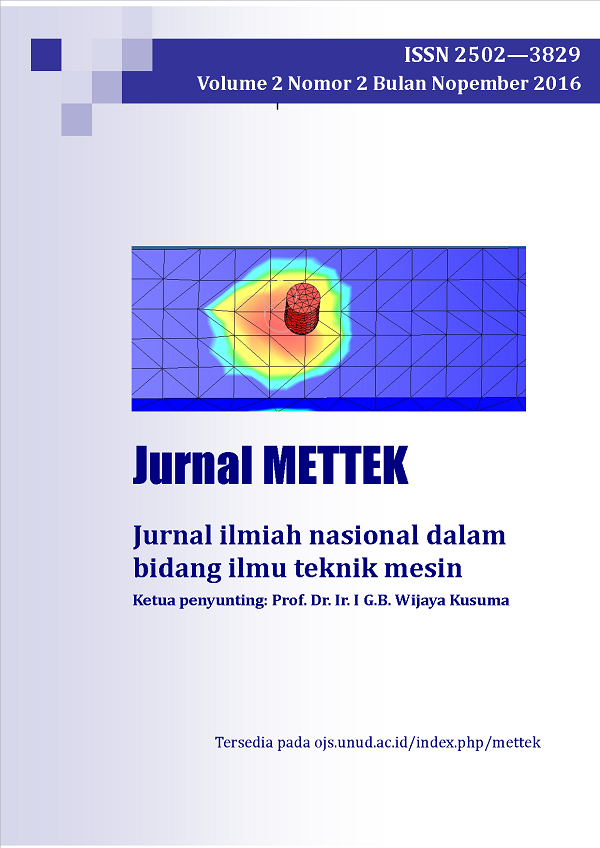ANALISA KINERJA THERMAL KOLEKTOR SURYA BERBASIS PIPA KALOR
Abstract
Salah satu pemanfaatan energi matahari adalah sistem pemanas air energi surya (solar water heater). Solar water heater yang banyak digunakan adalah solar water heater konvensiaonal dimana untuk mensirkulasikan fluida kerja pada kolektor surya menggunakan pompa sehingga masih menggunakan energi listrik yang sebagian besar bersumber dari energi fosil. Untuk mengurangi penggunaan energi listrik yang bersumber dari fosil tersebut sudah banyak dikembangkan solar water heater dengan menggunakan evacuated tube collectors yang memanfaatkan sirkulasi fluida secara alami. Karena sirkulasi fluida kerja pada evacuated tube collectors hanya memanfaatkan efek grafitasi dan lintasan uap dan cairan pada lintasan yang sehingga terjadi kekeringan dan kollektor menjadi tidak berfungsi. Dari beberapa penelitian yang telah dilakukan, pipa kalor memang memiliki keunggulan tersendiri. Keuntungan dalam pemanfaatan pipa kalor sebagai penukar kalor atau pendingin diantaranya siklus pemindahan kalor yang relatif lebih singkat, kekompakan dimensi, menigkatkan koefisien perpindahan kalor yang cukup tinggi serta tidak diperlukannya daya tambahan karena sirkulasi terjadi secara natural. Dalam penelitian ini kolektor surya dibuat menggunakan tabung kaca yang divakum dengan berbasis pipa kalor yang kemudian dirangkaikan sehingga menjadi sistem pemanas air yang berbasis pipa kalor. Dari hasil pengujian kolektor surya berbasis pipa kalor mampu memanaskan air hingga temperatur 71oC dengan laju aliran air 1 lpm. Hambatan termal tertinggi terjadi pada pukul 09.00 sebesar 0,388 Watt/oC, terkecil pada pukul 14.30 sebesar 0,027 Watt/oC.
One of the utilization of solar energy is solar energy water heating systems. Solar water heater is the widely used on conventional solar water heater in which to circulate the working fluid in the solar collector using a pump so they use electrical energy which are largely sourced from fossil fuels. To reduce the use of electricity that comes from the fossil has been developed using a solar water heater with evacuated tube collectors that utilize natural circulation of fluid. Due to the circulation of the working fluid in the evacuated tube collectors utilize only the effects of gravity and the trajectory of vapor and liquid on the track, causing drought and kollektor become dysfunctional. Of the few studies that have been conducted, the heat pipe does have its own advantages. The advantage in the use of heat pipe as heat exchanger or cooling cycle including the removal of heat is relatively short, compactness dimensions, enhances heat transfer coefficient is high enough and no additional power needed for the circulation occurs naturally. In this study the solar collector is made using glass tubes that vacuum with heat pipe which is then sequenced so that a heat pipe solar water heater. From the test results based heat pipe solar collector is capable of heating water to a temperature of 71oC with the flow rate of water 1 lpm. The highest thermal barriers at 09.00 amounted to 0,388 Watt /oC, the smallest in 14.30 amounted to 0,027 Watt /oC.
Downloads
References
G. Bourke and P. Bansal, “New Test Method For Gas Boosters With Domestic Solar Water Heater,” Solar Energy, Vol. 86, pp. 78-86, 2012
T. Kaya and J. Goldak, “Numerical Analysis of Heat and Mass Transfer in The Capillary Structure of a Loop Heat Pipe,” International Journal of Heat and Mass Transfer, vol. 49, pp.3211-3220, 2006
V.M. Kiseev, V.V. Vlassov, and I. Muraoka, “Experimental Optimization ofpillary Structures for Loop Heat Pipes and heat switches,” Applied Thermal Engineering, Vol. 30, pp.1312-1319,2010
A. A. Pawar, D. B. Shelke, “Thermal performance of wickless heat pipe solar collector with surfactant added nanofluid and solar tracking- A Review,” International Journal of Science, Engineering and Technology Research (IJSETR), Volume 4, Issue 1, January 2015
D.A. Redpath, “Thermosyphon Heat-Pipe Evacuated Tube Solar Water Heaters For Northern Maritime Climates, “ Solar Energy, Vol. 86, pp. 705-715, 2012
D. Reay, R. Mc Glen, and P. Kew, Heat Pipes: Theory, Design and Applications: Butterworth-Heinemann, 2013
D. Septiadi, “Proyeksi Potensi Energi Surya Sebagai Energi Terbarukan (Studi Wilayah Ambon dan Sekitarnya),” Jurnal Meteorologi dan Geofisika, Vol. 10, 2009
D.A.G. Redpath, P. C. Eames, S. N.G. Lo, P. W. Griffiths, “Experimental investigation of natural convection heat exchange within a physical model of the manifold chamber of a thermosyphon heat-pipe evacuated tube solar water heater,” Solar Energy 83 988-997. 2009
D.A.G. Redpath, “Thermosyphon Heat-pipe Evacuated Tube Solar Water Heaters for Northern Maritime Climates,” Solar Energy 86 705-712, 2012
L.L. Vasiliev, Heat pipes in modern heat exchangers, Applied Thermal Engineering, vol. 25, pp. 1-19. 2005
N. Putra, W. N. Septiadi, H. Rahman, and R. Irwansyah, “Thermal performance of Screen Mesh Wick Heat Pipes With Nanofluids,” Experimental Thermal and fluid Science, vol. 40 pp. 10-17, 2012
N. Putra, R. A. Koestoer DEA, W. N. Septiadi, Pengembangan Solar Kolektor berbasis Pipa Kalor Dengan Fluida Kerja Nano Fluida, Universitas Indonesia, 2014
N. Putra, W. N. Septiadi, “Teknologi Pipa Kalor,” Teori, Desain dan Aplikasi, Universitas Indonesia, 2014
N. G. Yoga, A. Suwono, Abdurrachim, T. Hardianto, “Kaji Eksperimental Penggunaan Pipa Kalor Dalam Kollektor Surya Sebagai Penyerap Energy Termal Surya Untuk Penyuplai Pompa Kalor Temperatur Tinggi”, SNTTM ke-9, Palembang 2010
Keywords

This work is licensed under a Creative Commons Attribution-NonCommercial-ShareAlike 4.0 International License.







